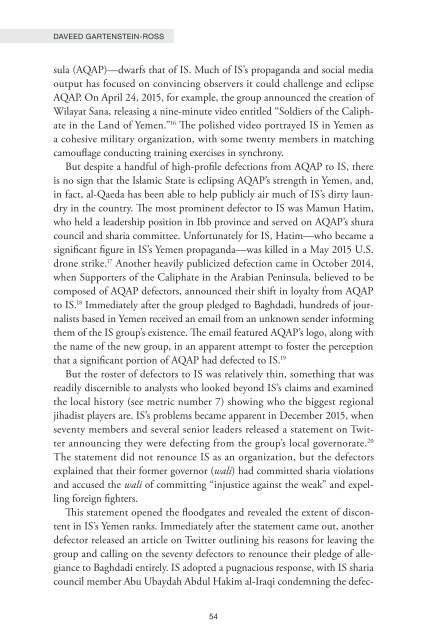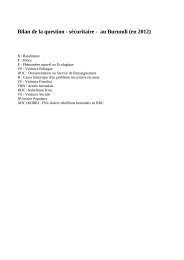Create successful ePaper yourself
Turn your PDF publications into a flip-book with our unique Google optimized e-Paper software.
DAVEED GARTENSTEIN-ROSS<br />
sula (AQAP)—dwarfs that of IS. Much of IS’s propaganda and social media<br />
output has focused on convincing observers it could challenge and eclipse<br />
AQAP. On April 24, 2015, for example, the group announced the creation of<br />
Wilayat Sana, releasing a nine-minute video entitled “Soldiers of the Caliphate<br />
in the Land of Yemen.” 16 The polished video portrayed IS in Yemen as<br />
a cohesive military organization, with some twenty members in matching<br />
camouflage conducting training exercises in synchrony.<br />
But despite a handful of high-profile defections from AQAP to IS, there<br />
is no sign that the Islamic State is eclipsing AQAP’s strength in Yemen, and,<br />
in fact, al-Qaeda has been able to help publicly air much of IS’s dirty laundry<br />
in the country. The most prominent defector to IS was Mamun Hatim,<br />
who held a leadership position in Ibb province and served on AQAP’s shura<br />
council and sharia committee. Unfortunately for IS, Hatim—who became a<br />
significant figure in IS’s Yemen propaganda—was killed in a May 2015 U.S.<br />
drone strike. 17 Another heavily publicized defection came in October 2014,<br />
when Supporters of the Caliphate in the Arabian Peninsula, believed to be<br />
composed of AQAP defectors, announced their shift in loyalty from AQAP<br />
to IS. 18 Immediately after the group pledged to Baghdadi, hundreds of journalists<br />
based in Yemen received an email from an unknown sender informing<br />
them of the IS group’s existence. The email featured AQAP’s logo, along with<br />
the name of the new group, in an apparent attempt to foster the perception<br />
that a significant portion of AQAP had defected to IS. 19<br />
But the roster of defectors to IS was relatively thin, something that was<br />
readily discernible to analysts who looked beyond IS’s claims and examined<br />
the local history (see metric number 7) showing who the biggest regional<br />
jihadist players are. IS’s problems became apparent in December 2015, when<br />
seventy members and several senior leaders released a statement on Twitter<br />
announcing they were defecting from the group’s local governorate. 20<br />
The statement did not renounce IS as an organization, but the defectors<br />
explained that their former governor (wali) had committed sharia violations<br />
and accused the wali of committing “injustice against the weak” and expelling<br />
foreign fighters.<br />
This statement opened the floodgates and revealed the extent of discontent<br />
in IS’s Yemen ranks. Immediately after the statement came out, another<br />
defector released an article on Twitter outlining his reasons for leaving the<br />
group and calling on the seventy defectors to renounce their pledge of allegiance<br />
to Baghdadi entirely. IS adopted a pugnacious response, with IS sharia<br />
council member Abu Ubaydah Abdul Hakim al-Iraqi condemning the defec-<br />
54






